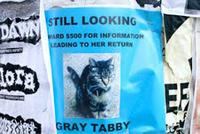
Found: Nothing Missing
Patricia McInroy - 2009, 3:00, Video, Denver, CO
Found: Nothing Missing uses missing pet posters to explore the larger meaning of loss. Still images are cut together to form a loose narrative and signs are deconstructed, using humor, in order to re-construct meaning for the viewer.

Patricia McInroy graduated with an MFA in Visual Arts from Vermont College of Fine Arts in 2007. Her video work has screened at film festivals in New Mexico, Arizona, Texas, New York and California. She taught as an adjunct instructor at the University of New Mexico and currently teaches at the Art Institute of Colorado.
Interview
ATA: Had you been collecting images of signs before the idea for the video came about, or did the idea surface first?
PM: I took the photos as the idea was surfacing, but the video emerged later. The idea stemmed from the way that I tend to mis/read signs literally or take another meaning from them. I had already made a video called "Signs" related to this piece. So I was in the habit of photographing signs, but with a different objective in mind.
ATA: Have you yourself lost a pet, or found a lost pet that you returned via a "lost" sign?
PM: I have not lost a pet, except to death. Although I've returned three dogs to people since making this video, none of them had posters up. Part of my sensibility regarding this subject actually comes from covering death as a photojournalist.
Using pet posters is a way to sneak up on people with the subject of death and loss. We have learned to desensitize ourselves, partly through the media, to the deaths of strangers. People are often more readily sympathetic to tragedy involving animals.
When I was working as a photojournalist, I also found out that many dogs get lost on the 4th of July. That's when I noticed the lost poster which set the project into motion. Unfortunately, many black cats also disappear around Halloween, which is when another important poster for this project emerged.
ATA: Some of your work seems to address the internal life of inanimate objects -- the relationships humans project onto things. Can you tell us a little bit about your motivations for making your work?
PM: It wasn't until I was able to step back from journalism and learn about conceptual art through graduate school that inanimate objects came to life for me. This somehow intersected with my personal exploration of trauma and the multiple deaths that I was exposed to as a journalist. It might be accurate to say that I am attempting to intersect these worlds of inanimate art and death, but by using humor as leverage. In this way, I hope both the subject matter and the piece are more accessible to viewers.
ATA: What should I have asked you?
PM: As a former journalist, I've always loved that question. I would ask….
What have you lost or found while realizing this work?
I did not realize I was on the verge of so much personal loss when I began working on this piece. A part of me wonders if my unconscious was aware of this and was somehow communicating or processing loss with me through the images and loose storyline.
Interview by Liz Wing of ATA


